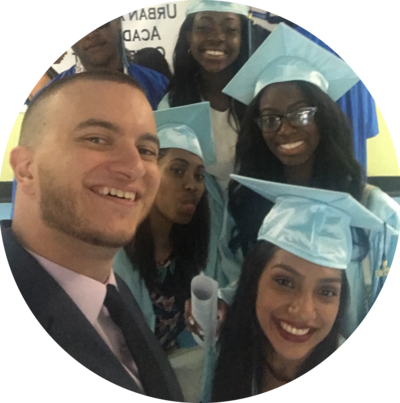How do teachers captivate their students? Here, in a feature we call How I Teach, we ask great educators how they approach their jobs. You can see other pieces in this series here.
Nick Viscomi remembers walking into world history class as a ninth-grade student and being tossed a burlap sack. His teacher told him to sit on the floor for a lesson about feudal Europe in which he would play the role of unfortunate peasant.
The lesson made an impression on Viscomi and helped set him on the path to his eventual career. Today, Viscomi is a second-year teacher who makes lessons come alive for his own students taking advanced placement U. S. History at Urban Assembly Academy of Government and Law in Lower Manhattan.

“Teaching has always been the profession that was for me,” he said. “This is my life.”
A self-proclaimed history nerd, his classroom is stuffed with cutouts of past presidents and Americana decor. Viscomi puts in brutally long hours — meeting with students during lunch and after school — because letting students know “you’re invested in them shows them they have to be invested in the work that they do.”
He relishes the opportunity to help his students become active and engaged citizens. That’s why he jumped on the chance to join young people from across the country as they gathered in Washington D.C. earlier this month to develop a national plan to combat gun violence.
“They are fed up with just hearing about thoughts and prayers,” he said of today’s teens. “They want to see concrete steps to make sure students feel safe in classrooms.”
It’s a conviction his students, some of whom have witnessed or been personally affected by gun violence, share.
Here’s what Viscomi had to say about the lessons he’s learned as a novice teacher, and the challenge of being “on” all the time.
Responses have been edited for length and clarity.
How do you get to know your students?
I get to know my students by taking the time to talk to them about things outside of the classroom. Unless I have a meeting, every lunch I have kids in the room with me where we talk about everything that is going on in their lives from what they’re watching on TV and friend and relationship problems to what their plans are for after high school. Most days you can find me in my classroom until 6:00 p.m., hanging out with kids and doing work together. These are the moments where I really feel I can connect with them on a personal level.
Tell us about a favorite lesson to teach. Where did the idea come from?
One of my favorite lessons to teach is World War I and trench warfare. I create a 8×8 grid on the ground with masking tape and create a series of maps where there are obstacles in the maze. I then divide the students into two teams and have them attempt to cross the grid. The students must use trial and error as well as teamwork to get their entire team across safely. The activity gets particularly fun when the students get the hang of it, and I take away their ability to speak during the activity. This helps the students understand the difficulties of trench warfare. I got this idea from my time as a Resident Assistant in college. This was a team-building activity that we did each year, and it works perfectly with the kids.
Give us a sense of what a normal day looks like for you.
On a normal day my alarm goes off at 5 a.m. I wake up, make breakfast, feed my cat and then head into work at around 6 a.m. In the morning I make copies, tweak lesson plans, and grade assignments as I prepare for the day that starts at 8:32. I have first period off so I usually take that time to run errands in the school or catch up with my seniors who are arriving for first period study hall with another teacher in my room. I then teach three Advanced Placement U. S. history classes with the juniors back-to-back before having lunch. Lunch is usually hectic with kids in and out for student-government related questions and others coming back from local food spots to spend half an hour relaxing. After lunch I teach freshmen advisory, followed by my one section of AP U.S. for seniors. By 8th period — my second prep — I am usually exhausted and take the time to organize my room and life. After school I plan lessons, make more copies and grade more assignments but now with the company of two to five kids who are hanging out. This is my favorite time of the day, when I really get to recharge and laugh with the kids. I usually leave the building around 6 p.m. to go crash on my couch, try and unwind and then go to bed early — to do it all again the next day!
What supports do you rely on during the school day?
During the school day, I find myself relying on small positive interactions with students as my support system. Due to the small nature of my school, co-workers are usually busy during the day. The laughs I share with students, the moments of understanding we share, or even just a genuine thank you from a student are what get me through the day. These small moments with students might not seem like much but they help to recenter me and remind me why I do what I do. These moments add up with students and help me to form the type of relationships with them where we are both positive influences in each others’ lives.
What’s something happening in the community that affects what goes on inside your class?
Gun violence impacts my students. Many come from communities where gang violence is a regular occurrence. Our school participated in the national walkout last year, and many of our students are passionate about gun safety. I was fortunate to attend the Student Gun Violence Summit in Washington, D.C. in October of this year. The summit was a weekend-long event organized and led by students in order to draft a student Bill of Rights on gun safety. Students from all over the country including Newtown, Connecticut and Parkland, Florida attended the summit. We participated in panels, breakout sessions, and brainstorming activities as the students prepared to draft the actual Bill of Rights Sunday morning to conclude the summit. It was truly incredible being with 100 kids from all over the country who are so passionate and knowledgeable about the topic. The students were able to draft a Bill of Rights that they plan to bring back to their communities and rally support behind it while pressuring those in politics to adopt the ideas in it to help make schools a safer place.
What part of your job is most difficult?
The most difficult part of my job by far is having to be on all the time. No matter how little sleep I have gotten, no matter what is happening in my personal life, no matter what a student said to me a period before, I have to be on my game and ready for anything. Being on means not taking out your personal problems on the students and overreacting to them being teenagers. This is also the most draining aspect of the job. As an introvert, I find myself giving all day to maintain my relationships with students so that by the end of the day, I need quality time with a quiet room and a book. This is why I rely so much on those small, positive interactions with the kids. Those moments help me get a quick recharge on my internal battery and help me maintain a constant positive attitude in the classroom.
What’s the best advice you’ve received about teaching?
The best advice I have received in teaching was to be myself. I know, that’s simple, but kids are the best people in the world at sniffing out someone who is not genuine. A teacher who gets up in front of a room and fakes it everyday will never truly have kids as a captive audience, will never really have good relationships with them. I was told to be myself early in student teaching and the advice stuck. I never fake it in the classroom and I firmly believe that is one of the reasons I am able to form such strong relationships with my students.
Tell us about a memorable time — good or bad — when contact with a student’s family changed your perspective or approach.
I don’t have a truly singular story about an interaction with a student’s family that shaped the way I think about my work. However, many of my students come from home lives that are less than ideal — and that helps keep me grounded and patient in my work. Chances are if a student is acting out in class, there is something going on at home. I have found that forming truly caring relationships with students is the most important aspect of my job. All students deserve someone they can go to for advice and comfort when they are overwhelmed by life.
What was your biggest misconception about teaching?
I think my biggest misconception was that it could be a job where you can separate work from the rest of your life. I knew it would involve long hours and weekends grading and lesson planning — that was not a surprise. What I did not expect is the impact the kids would have on my personally, and how invested I would become in their success both inside and outside the classroom. Even if I get home with work to do, I am still thinking about conversations I had during the day with my kids and the challenges they may be facing. I am always thinking about ways I can best support them and help them through whatever they are dealing with.

